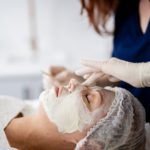Facial Exfoliation – where to begin?
Our skin cells have a natural life cycle that sees them rise from the lower skin levels and flatten as they develop, until they mature and are shed as dead particles from the top layer (the stratum corneum).
As we age, the cells in the stratum corneum become stickier and are harder to shed, leading to a build up of the dead top layer of skin. This can give the skin a lacklustre dullness and make it more challenging for active ingredients in our skincare products to penetrate.
The answer to this issue is regular exfoliation.
Regular exfoliation will remove that dead top layer and reveal the more radiant healthy skin layers beneath. This is a simple step that we generally recommend you add to your skincare routine from your early 20s (but it is never too late!) or earlier if you are a acne sufferer.
There are a number of ways that exfoliation can be achieved, which can be mixed and matched to suit lifestyle and budget.
Physical exfoliation
You can clean and exfoliate at the same time using your normal gentle cleanser if you apply and remove this with a light abrasive cloth. This is a cost effective, easy solution and may be enough for young, non-acne prone skin. Muslin is a great option and can be cleaned and reused. You can buy ready-made muslin cloths specifically for this, or if you are feeling crafty you can pop into Spotlight for some muslin and make your own. Other examples would be facial buffers, exfoliating mitts and the fancier version made of 100% floss silk (eg Microdermamitt®) which are available online as well as from the bathroom section of department stores, pharmacies and skincare stores.
Facial scrubs
Another way to cleanse and exfoliate in one step is with a facial scrub, which is a cleanser with something gritty added to it. Avoid scrubs with plastic microbeads (banned in many countries as they are harmful to aquatic life) and choose biodegradeable products instead, which tend to use substances such as natural earth minerals (eg Synergie® Mediscrub) or nut shells as their exfoliant (eg Aesop Tea Tree Leaf Facial Exfoliant). If you are a coffee fan, you can use your left-over grounds to make your own facial and body scrubs.
Tap into our medical expertise
We understand that the world of aesthetics and cosmetic treatments can be intimidating, that’s why our cosmetic doctors and qualified dermal therapists are here.
To share our medical knowledge. To help you look and feel your best.
Chemical Exfoliation
This sounds scary but it merely involves using substances such as light fruit acids to dissolve the sticky bonds between the matured skin cells in the stratum corneum, allowing them to fall off naturally without any sort of physical rubbing. The most commonly used chemical exfoliants are alpha hydroxy acids (AHAs- see below) and beta hydroxy acids (BHAs) such as salicylic acid. These are often combined and applied as a serum (eg Synergie® Reveal) between the cleansing and moisturising steps of a skin care regime. There are different preparations and strengths available for different skin needs and so it is good idea to seek appropriate advice for your individual skin before using a chemical exfoliant.
| AHA | Source |
|---|---|
| Glycolic Acid | Sugar Cane |
| Lactic Acid | Milk Products |
| Malic Acid | Apples |
| Tartaric Acid | Grapes |
| Citric Acid | Citrus Fruits |
Professional exfoliation
If daily home exfoliation is not enough for your skin, or doesn’t fit into your lifestyle, then regular clinic treatments may be for you. The simplest of these is microdermabrasion, which is literally a light mechanical sandpapering to remove the dead top layer of skin. Slightly more advanced are the hydrabrasion treatments, that use water to assist with the removal of the dead skin. Medical grade treatments such as the Hydrafacial® will have the same effect as a good microdermabrasion but with the additional benefit of a light chemical exfoliation and an infusion of nourishing ingredients into the skin.
Chemical peels
You can step it up even further and go with this alternative in-clinic option for removing that dead top layer of skin. Lactic or glycolic acids can be applied at stronger concentrations than are available in at-home products, and cause a gentle peeling of the entire uppermost skin layer over the following few days. Downtime is minimal due to the light superficial nature of these peels and side effects are rare. This sort of peel can be combined with a microdermabrasion for people with thicker or oily skins. This is definitely a treatment for the winter months as you should avoid exposing the skin to bright sunlight for a few days afterwards.

